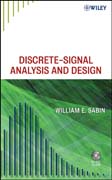
This book provides a clear, step-by-step approach to the practical use of discrete-time and discrete-frequency signal processing, which is rapidly becomingan important way to design and analyze electronics projects of all kinds. A full-featured copy of Mathcad 14.0 for Students is provided- and with unlimitedtime usage- to help the reader understand the basic principles of discrete-signal processing. INDICE: Introduction. 1. Define the goals of the book. 2. Define discrete signals. 3. The advantages of discrete-signal analysis and design. 4. Describethe DFT and IDFT. 5. Discuss the Mathcad program. 6. Discuss MATLAB and less expensive approaches. 7. Discuss Multisim program from National Instruments Co. 8. Discuss the Mathtype program. 9. Mention LabVIEW. 10. Mention Search Engines. 11. Discuss the personal productivity software capability. Chapter 1: First Principles 1. Sequence structure in time domain and frequency domain. 2. Two-sided time and frequency. 3. The discrete Fourier transform. 4. The inverse discrete Fourier transform. 5. Frequency and time scaling. 6. Number of samples needed. 7. Complex frequency domain sequences. The phasor concept. 8. Time x(n) vs frequency X(k). Chapter 2: Sine, Cosine and Theta. 1. One-sided sequences. 2. Combinations of two-sided phasors 3. Time and spectrum transformations.4. Transforming two-sided phasor sequences into one-sided sine, cosine, 5. Example 2-1, nonlinear amplifier distortion and square law modulator. 6. Example2-2, analysis of the ramp function. Chapter 3: Spectral Leakage and Aliasing.1. Spectral leakage. Non-integer values of time and frequency. 2. Scaling of frequency reduces leakage. Example 3-1. 3. Aliasing in the two-sided frequencydomain. 4. Aliasing in the positive frequency domain. 5. Example 3-2. Analysis of frequency domain aliasing. 6. Time domain aliasing. Chapter 4: Smoothing and Windowing. 1. Smoothing the rectangular window, without noise and with noise. 2. Smoothed sequences near the beginning and end. 3. Signal to noise ratioof a smoothed sequence. 4. Three-point smoothing and seven point smoothing. 5. Windowing in the time and frequency domains. 6. The rectangular window (review Ch. 3). 7. The Hamming Window. 8. The Hanning (Hann) Window. 9. Relative merits of the three windows. 10. Lobe amplitudes of the three types of windows. 11. Behavior of windows near k = 1 and 2. 12. Scaling the windows for improvedfrequency resolution. Chapter 5: Multiplication and Convolution 1. Sequence multiplication. 2. Polynomial multiplication. 3. Discrete Convolution basic equation. 4. Relating convolution to polynomial multiplication. 5. The fold and slide concept. 6. Circular discrete convolution (try to avoid). 7. Sequence time and phase shift. 8. The DFT and IDFT of discrete convolution. 9. Fig 5-6. Compare convolution and multiplication. 10. De-convolution. Chapter 6: Probability and Correlation 1. Expected value of noiseless sequence. 2. Include some additive noise. 3. Envelope detection of noisy sequence. 4. Power of noiseless sequence. 5. Power of noisy sequence. 6. Sequence averaging. 7. Variance (AC component). 8. Gaussian (normal) distribution. 9. Cumulative distribution (CDF).10. Autocorrelation of a sequence. 11. Cross correlation of two sequences. 12. Auto-covariance. 13. Cross-covariance. 14. Correlation coefficient. Chapter 7: Power spectrum. 1. Finding the power spectrum using Eq 7-1. 2. Two-side phasor spectrum, one-side power spectrum. 3. Example 7-1. See Fig 7-2. 4. Random Gaussian noise spectrum. 5. Measuring power spectrum. 6. Spectrum analyzer example. 7. Wiener-Kintchine theorem. 8. System power transfer Eq 7-6. 9. Cross power spectrum. 10. Example of calculating phase noise. Chapter 8: Hilbert Transform. 1. The perfect Hilbert transformer. 2. Example of a Hilbert transform of a square wave. 3. Illustrate smoothing of the Example. 4. Explanation of peaks in Hilbert of square wave. 5. Mathematics of the Hilbert transform. 6. The analytic signal. 7. Example of construction of analytic signal. 8. Single-sideband RF signals. 9. SSB design. 10. The basic all-pass network. 11. -90 cascaded phase shift audio network. 12. Why the -90 network is not equivalent to a Hilbert transformer. 13. Filter method SSB transmitter. 14. Phasing method SSB receiver. 15. Filter method SSB receiver. Appendix A: Additional discrete-signal information 16. Discrete derivative. 17. State variable solutions. 18. Using the discrete derivative. Glossary. Index.
- ISBN: 978-0-470-18777-7
- Editorial: John Wiley & Sons
- Encuadernacion: Cartoné
- Páginas: 192
- Fecha Publicación: 01/02/2008
- Nº Volúmenes: 1
- Idioma: Inglés
